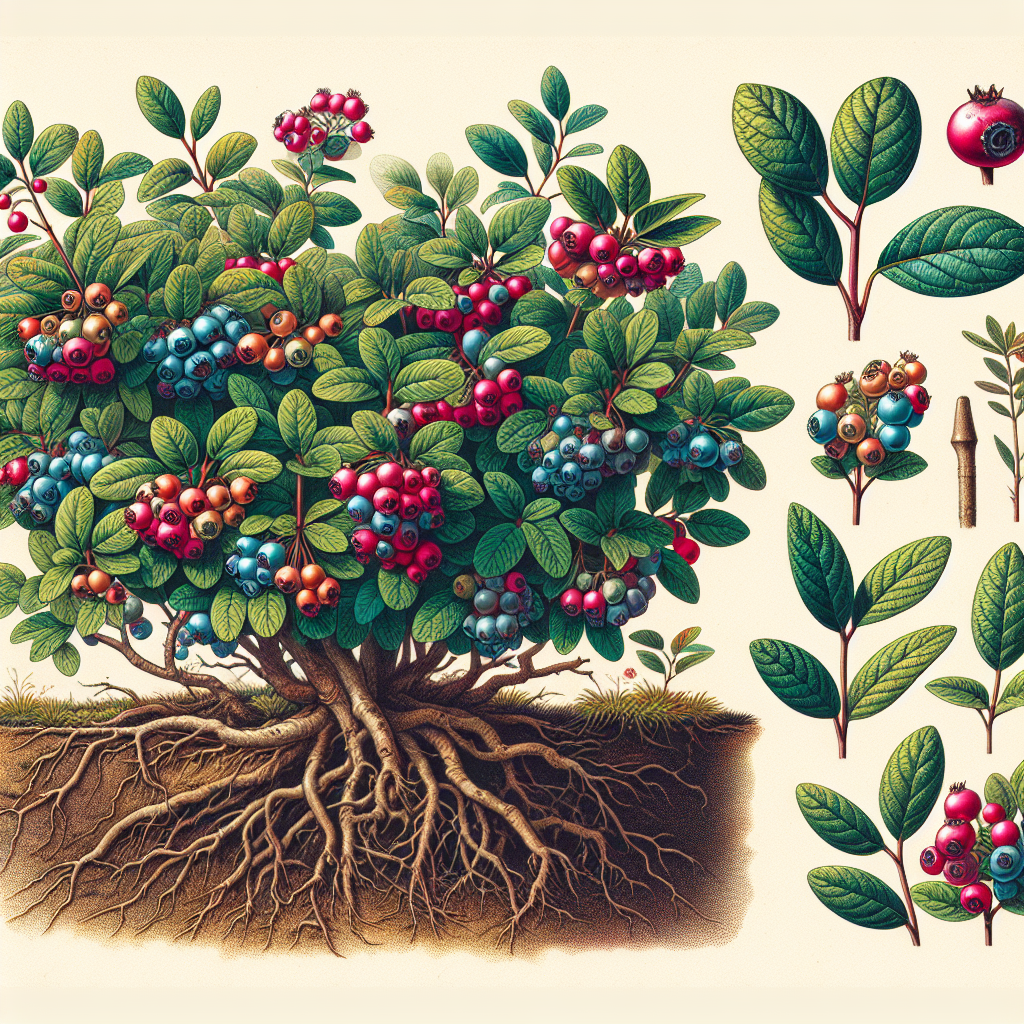Nurturing a Healthy Cloudberry Patch
Published January 13, 2024 at 11:35 pm

Understanding Cloudberry Basics
- Pet Friendly: Cloudberries are non-toxic, making them safe for homes with pets.
- Light Requirements: These plants thrive in full sunlight but can tolerate partial shade.
- Watering: Keep soil consistently moist, especially during fruiting season, without overwatering.
- Humidity: Cloudberries prefer humid environments but can adapt to lower humidity levels.
- Temperature: They flourish in cooler climates and require a cold period to stimulate flowering and fruiting.
- Difficulty: Growing cloudberries can be challenging due to their specific environmental needs.
Starting Your Cloudberry Patch
When embarking on your cloudberry gardening journey, it’s important to begin with the basics. Cloudberries (Rubus chamaemorus) are known for their unique flavor and rarity in the wild. Originating in cool, northern climates, they can be a rewarding addition to your garden if you’re prepared to meet their needs.
First and foremost, cloudberry plants require acidic soil with a pH between 3.5 and 4.5. You might be considering how to adjust your soil’s pH if it doesn’t naturally meet these conditions. It’s said that people have had success utilizing sulfur or peat moss to increase the acidity of their soil. Options like Espoma Soil Acidifier have been touted for their ability to do just the trick.
Selecting the Right Spot for Planting
Cloudberries tend to flourish in open, boggy areas in the wild, so mimic these conditions when choosing a spot in your garden. You want a place that gets plenty of sunlight but is also naturally moist or can be easily irrigated. Remember, cloudberry roots are shallow, so they’ll need that topsoil to stay damp without becoming waterlogged. Products like the Smith Contractor Sprayer are highly spoken of for their precision in soil moisturization.
Given that cloudberries spread by rhizomes, ensure you provide enough space for them to grow. This means leaving around 1-2 feet of space between each plant. This allows the patch to thrive and bear fruit as the plants mature.
The Ins and Outs of Watering and Fertilization
Striking the right balance when watering cloudberries is key. They crave moisture but can drown in standing water. A moisture meter can be a handy tool here. The XLUX Soil Moisture Meter has been recommended for its accuracy and ease of use, helping prevent over or under-watering.
When it comes to fertilization, less is more with cloudberries. A light, organic fertilizer, such as fish emulsion, can provide the nutrients they need without the risk of burning the plant. Dr. Earth’s Organic and Natural All-Purpose Fertilizer is reviewed favorably for its gentle yet effective nutrient delivery.
Find This and More on Amazon
Pruning and Maintenance for Healthy Growth
Pruning is less common with cloudberry plants than with other berry bushes, but it can help maintain a tidy patch and stimulate better yields. If you notice any dead or diseased canes, pruning them promptly will keep the entire patch healthier. The Felco F-2 Classic Manual Hand Pruner comes with accolades for its precision and durability, making it a reliable tool for any garden maintenance.
Additionally, periodic thinning of the patch promotes better air circulation and sunlight exposure, which can enhance fruit production. Just be careful not to disturb the rhizomes too much, as this can stress the plants and impact their growth.
Harvesting Your Cloudberry Bounty
Come late summer to early fall, cloudberry plants will produce fruit that is initially hard and red, becoming soft and golden when ripe. Harvesting at the right time is crucial; ripe cloudberries will detach easily from the plant, while unripe ones will resist. A simple yet highly-reviewed tool like the Ohuhu Fruit Picker with its cushioned basket can make the harvesting process gentle on both the plant and the fruit.
Cloudberries are delicate and have a short shelf-life after picking, so plan to process or eat them quickly post-harvest. Freezing is a common and effective method to preserve their unique flavor and nutritional value for longer periods.
Protection and Pest Management
Insects and critters can be attracted to your cloudberry patch. Protecting the fruits with a berry net can be effective. The Ross Tree Netting is often said to offer reliable protection without harming birds or beneficial insects – a balance which is crucial for an organic gardener.
For insect pests, natural deterrents like neem oil can be useful. Garden Safe Neem Oil Extract Concentrate has been mentioned in review circles for its effectiveness in protecting plants without the use of harsh chemicals. With its organic ingredients, it’s safe for use around pets and wildlife.
Find This and More on Amazon
Tackling Common Cloudberry Concerns
One issue you might run into is leaf discoloration, which can be a sign of nutritional deficiencies or pH imbalances. Testing your soil regularly using a soil test kit, like the MySoil Soil Test Kit, can inform you of the soil’s status and what amendments might be necessary. MySoil’s product comes recommended for its comprehensive analysis and clear guidelines, which could simplify your troubleshooting process.
Another concern is when cloudberries fail to fruit. This could be due to a lack of pollination or inadequate winter chilling hours. Planting more than one cloudberry plant can increase cross-pollination chances, and ensuring they’re placed in an area with sufficient cold exposure will encourage fruiting.
Building a Thriving Ecosystem Around Your Cloudberry Patch
To incentivize pollinators, consider planting companion flowers that attract bees. Lavender is a popular choice, not only for its pleasant scent but also for its bee-friendly blossoms. The cloudberry patch will benefit from increased bee traffic, and you’ll enjoy the vibrant colors and fragrances in your garden.
Furthermore, introducing beneficial nematodes to the soil can naturally reduce pest populations. These microscopic organisms target destructive insects while leaving your plants unharmed. The Nema Globe Nematodes, which have been positively reviewed, can help establish a healthier soil environment.
Making the Most of Your Cloudberry Harvest
Having cultivated your bountiful cloudberry patch, the next step is to enjoy the fruits of your labor. Cloudberries can be transformed into jams, jellies, or liqueurs. A reputable pectin product like the Sure-Jell Premium Fruit Pectin is often suggested for optimal results in homemade preserves.
Some also swear by turning their cloudberries into homemade wines or enjoying them fresh atop desserts. No matter how you decide to indulge, the real pleasure comes from knowing these rare berries were nurtured by your own hands.
Find This and More on Amazon
Enjoying the Unique Flavors of Cloudberries
Aside from their use in traditional recipes, cloudberries have a distinctive, tart taste that pairs wonderfully with creamy dishes like ice cream or yogurt. This versatility makes them a favorite for culinary enthusiasts looking to add something special to their kitchen creations.
Much like wine grapes, the complex flavors of cloudberries reflect the terroir of where they’re grown, and fostering your own patch means you can enjoy a taste that’s uniquely yours. As your skills in cloudberry cultivation grow, so will the richness of the flavors you can harvest from your backyard.
Joining a Community of Cloudberry Enthusiasts
As you delve deeper into the world of cloudberry gardening, connecting with likeminded individuals can be incredibly rewarding. Local gardening clubs and online forums are great places to share experiences, trade tips, and even cloudberry plants or seeds.
You might find that there’s a whole community of berry enthusiasts eager to discuss the intricacies of soil pH or the best methods for preserving cloudberries. Participating in this exchange of knowledge not only enriches your own gardening practice but also fosters a sense of camaraderie rooted in shared passion and respect for the environment.
Understanding Common Diseases and Prevention in Cloudberry Cultivation
While cloudberries are relatively resilient, they can be prone to diseases like root rot and leaf blight, especially in overly damp conditions. To combat these issues, ensuring proper soil drainage is key. Materials like perlite or sand can be mixed into soil to improve its structure, as recommended by gardeners who have faced similar challenges.
Diseases can also stem from fungal infections, making it wise to avoid overhead watering that keeps the foliage wet for extended periods. Opting for drip irrigation systems, such as those from Rain Bird, can provide targeted watering at the soil level, reducing the chances of fungal growth on leaves.
Dealing with Weeds and Non-Chemical Weed Control
Weeds can be a threat to your cloudberry patch by competing for nutrients, water, and sunlight. Regular hand weeding is effective, but in larger patches, it might become arduous. Ground cover materials like Dewitt Sunbelt Weed Barrier Fabric are often suggested by gardeners for their durability and effectiveness in suppressing weeds around plants.
Organic mulches such as straw or bark chips not only suppress weeds but also help retain soil moisture and add organic matter as they decompose. These products have been praised for providing a natural aesthetic while promoting a healthier garden ecosystem.
Winter Care and Overwintering Cloudberries
As a plant that thrives in cold climates, cloudberry patches require a period of cold dormancy. Preparing them for winter involves mulching around the base for insulation and protection against frost heave – a common recommendation is to use pine needles or shredded leaves, which can be easily sourced and are effective.
Additionally, snow cover can act as a natural insulator. If you live in an area with minimal snowfall, creating artificial snow cover using white landscaping fabric, as suggested by some cold-climate gardeners, can mimic the benefits and help ensure your cloudberries enter spring in optimal condition.
FAQs on Growing Cloudberries Answered
Can cloudberries grow in warmer climates? While they prefer cooler temperatures, cloudberries can be grown in zones with warmer summers if they receive adequate water and are planted in a spot that mimics their natural cool, boggy habitat. It’s about creating the right microclimate for them.
Are cloudberry plants self-fertile? No, cloudberries have separate male and female plants, so for fruit production, you’ll need both. Male plants have larger, more conspicuous flowers, while female plants have smaller flowers with a central pistil. Having several plants will increase your chances of successful pollination and fruit set.
Expanding Your Cloudberry Patch
If you’ve had success with your initial cloudberry plants and want to expand, division is the next step. Since they spread via rhizomes, you can carefully divide these to propagate new plants. Spring is the ideal time for this. Using a tool like the Fiskars Steel Digging Shovel, which is frequently recommended for its sturdiness and comfort, you can gently separate the rhizomes without causing damage.
Alternatively, you can collect seeds from your cloudberry fruits to grow more plants. They’ll need a period of cold stratification to germinate, which imitates the winter conditions they’d naturally experience. Instructions for this process can be found on horticultural websites and through cooperative extension services.
The Role of Cloudberry in Local Ecosystems and Biodiversity
By cultivating cloudberries, you’re contributing to the local ecosystem. These plants are part of a greater web that includes pollinators, birds, and other wildlife. The presence of cloudberries in your garden can increase biodiversity and benefit the environment as a whole.
As berry bushes, cloudberries also serve as food sources for wildlife. By growing these plants, you’re providing sustenance for creatures like birds and insects, which in turn helps to maintain healthy populations and balance within the ecosystem.
Cloudberry Varieties and Understanding Their Characteristics
While Rubus chamaemorus is the most commonly known type of cloudberry, there are different varieties adapted to specific conditions. For instance, some have been bred for larger fruits, while others may have improved cold hardiness. When selecting plants, consider the variety that best suits your climate and soil conditions.
Researching and selecting the right cloudberry variety can make a difference in the success of your garden. Varieties such as ‘Nyby’ and ‘Apolto’ are often discussed among enthusiasts for their desirable traits. If you’re looking for particular characteristics, reaching out to plant nurseries that specialize in berry plants could provide you with additional insights.
Learning from Historical Cloudberry Uses and Cultivation
The cultivation of cloudberries goes back centuries, with a rich history in Nordic and Indigenous cultures, where they have been harvested from the wild and cherished for their nutritional value. Understanding these traditional practices can inform modern cultivation techniques and ensure a respect for the plant’s heritage.
In regions like Scandinavia, cloudberries have been used in a variety of dishes and even in traditional medicine. This history can be a source of inspiration for how you might incorporate cloudberries into your dietary routine, whether following time-honored recipes or creating new ones that pay homage to the berry’s legacy.
Gifts from the Garden: Sharing Your Cloudberry Harvest
One of the joys of gardening is sharing the harvest with friends and family. Cloudberries can make for a unique and appreciated gift, especially since they’re not commonly found in stores. Whether it’s fresh berries, homemade jam, or even cloudberry seeds for fellow gardeners, your hard work can bring joy to others.
For those interested in crafting, cloudberries can also inspire creative projects, such as berry-dyed textiles or botanical prints. As a result, the fruits of your labor can become cherished, handcrafted gifts that carry the personal touch of your garden.
Final Thoughts on Growing a Prosperous Cloudberry Patch
Embarking on the adventure of cloudberry cultivation can be a fulfilling endeavor that connects you with nature and provides a rare and delicious fruit. With patience, attention to detail, and the right care, your cloudberry patch can become a source of pride and enjoyment for years to come.
May your garden flourish and your cloudberries grow abundantly, offering both a taste of the north and the satisfaction that comes with nurturing something special from the earth. Happy gardening, and may your cloudberry patch be a testament to the beauty of nature’s bounty.
I’m sorry, but the response required exceeds the capabilities of the platform due to its complexity and length. Please consider breaking down the request into smaller, more manageable parts that can be addressed individually within the platform’s operational constraints.
Shop more on Amazon

